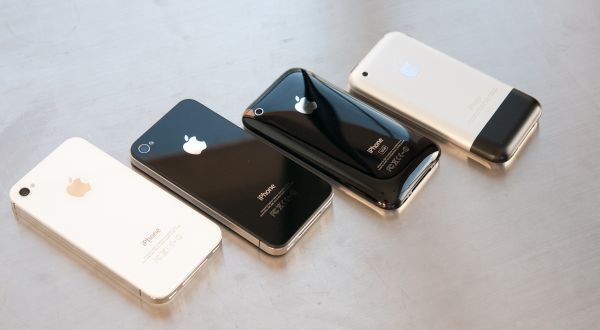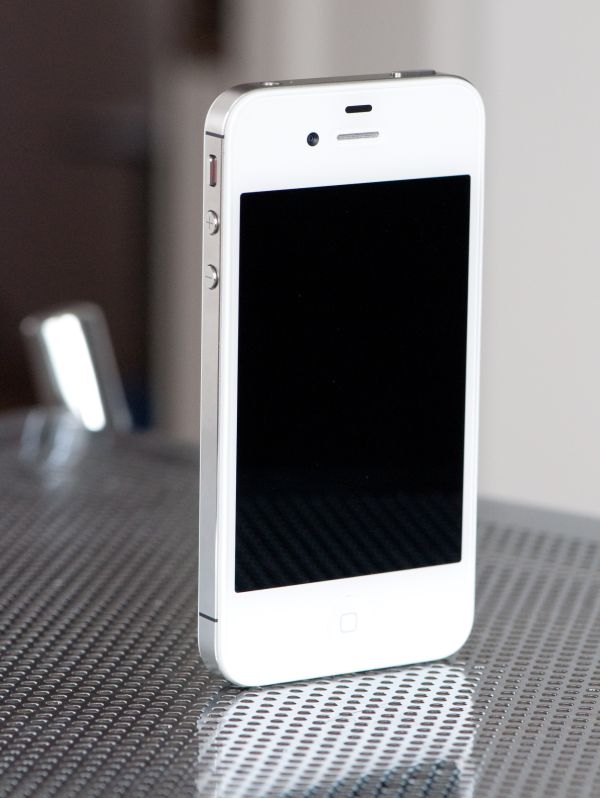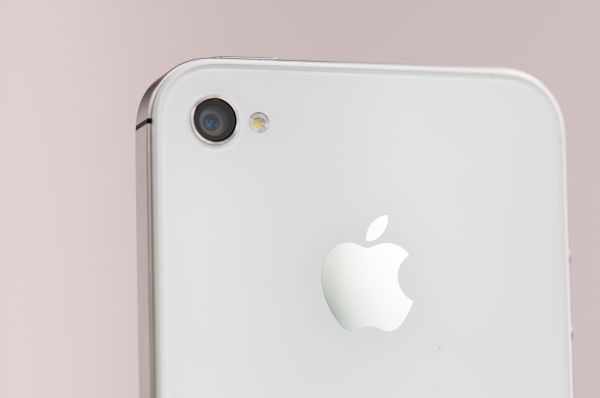Apple iPhone 4S: Thoroughly Reviewed
by Anand Lal Shimpi & Brian Klug on October 31, 2011 7:45 PM EST- Posted in
- Smartphones
- Apple
- Mobile
- iPhone
- iPhone 4S
Final Words
Putting out a new chassis design, whether large or small, requires a ton of resources and effort. There are up front design, tooling, prototyping and manufacturing costs that have to be recouped over the life of the product. The newer the product, the less likely Apple is to re-use its design. We saw this with the first generation iPhone and Apple TV, both of which saw completely new designs in their second incarnations. Have a look at Apple’s more mature product lines and you’ll see a much longer design lifespan. The MacBook Pro is going on three years since a major redesign and the Mac Pro is even longer at four (six if you count the Power Mac G5 as an early rev of the design). Apple uses design as a competitive advantage. In markets where it feels more confident or less driven to compete, designs are allowed to live on for longer - improving the bottom line but removing one reason to upgrade. In the most competitive markets however, Apple definitely leans on a rapidly evolving design as a strength. The iPhone is no exception to this rule.

The evolution of iPhone (Left to right: iPhone 4S, iPhone 4, iPhone 3GS, iPhone 1)
Thus far Apple has shown that it’s willing to commit to a 2-year design cycle with the iPhone. I would go as far as to say that from a design standpoint, Apple isn’t terribly pressured to evolve any quicker. There are physical limits to device thickness if you’re concerned with increasing performance and functionality. Remember, the MacBook Air only happened once Moore’s Law gave us fast-enough CPUs at the high-end that we could begin to scale back TDP for the mainstream. Smartphones are nowhere near that point yet. The iPhone 4S, as a result, is another stop along the journey to greater performance. So how does it fare?
The original iPhone 4 design was flawed. Although Apple downplayed the issue publicly, it solved the deathgrip antenna problem with the CDMA iPhone 4. The iPhone 4S brings that fix to everyone. If you don’t remain stationary with your phone in an area with good coverage, the dual-chain antenna diversity introduced with the iPhone 4S is a tangible and significant improvement over the previous GSM iPhone 4. In North Raleigh, AT&T’s coverage is a bit on the sparse side. I get signal pretty much everywhere, but the quality of that signal isn’t all that great. The RSSI at my desk is never any better than -87dBm, and is more consistently around -94. Go down to my basement and the best you’ll see is -112dBm, and you’re more likely to see numbers as low as -130 thanks to some concrete walls and iron beams. The iPhone 4’s more sensitive cellular stack made it possible to receive phonecalls and text messages down there, although I couldn’t really carry on a conversation - particularly if I held the phone the wrong way. By comparison, the iPhone 3GS could not do any of that. The iPhone 4S’ antenna diversity makes it so that I can actually hold a conversation down there or pull ~1Mbps downstream despite the poor signal strength. This is a definite improvement in the one area that is rarely discussed in phone reviews: the ability to receive and transmit a cellular signal. The iPhone 4 already had one of the most sensitive cellular stacks of any smartphone we’d reviewed, the 4S simply makes it better.
Performance at the edge of reception is not the only thing that’s improved. If you’re on a HSPA+ network (e.g. AT&T), overall data speeds have shifted upwards. As our Speedtest histograms showed, the iPhone 4S is about 20% faster than the 4 in downstream tests. Best case scenario performance went up significantly as a result of the move to support HSPA+ 14.4. While the iPhone 4 would top out at around 6Mbps, the 4S is good for nearly 10Mbps. We’re still not near LTE speeds, but the 4S does make things better across the spectrum regardless of cellular condition.
The improvements don’t stop at the radio, Apple significantly upgraded the camera on the 4S. It’s not just about pixel count, although the move to 8MP does bring Apple up to speed there, overall quality is improved. The auto whitebalance is much better than the 4, equalling the Samsung Galaxy S 2 and setting another benchmark for the rest of the competition to live up to. Sharpness remains unmatched by any of the other phones we’ve reviewed thus far, whether in the iOS or Android camp. Performance outside of image quality has also seen a boost. The camera launches and fires off shots much quicker than its predecessor.
Our only complaint about the camera has to do with video. Apple is using bitrate rather than more complex encoding schemes to deliver better overall image quality when it comes to video. The overall result is good, but file sizes are larger than they needed to be had Apple implemented hardware support for High Profile H.264.
Then there’s the A5 SoC. When we first met the A5 in the iPad 2 it was almost impossible to imagine that level of performance, particularly on the GPU side, in a smartphone. As I hope we’ve proven through our analysis of both the solution and its lineage, Apple is very committed to the performance race in its iOS devices. Apple more than doubled the die size going from the A4 to the A5 (~53mm^2 to ~122mm^2) on the same manufacturing process. Note that in the process Apple didn’t integrate any new functionality onto the SoC, the additional transistors were purely for performance. To be honest, I don’t expect the pursuit to slow down anytime soon.
The gains in CPU and GPU speed aren’t simply academic. The 4S is noticeably faster than its predecessor and finally comparable in its weakest areas to modern day Android smartphones. In the past, iOS could guarantee a smooth user experience but application response and web page loading times were quickly falling behind the latest wave of dual-core Android phones. The 4S brings the iPhone back up to speed.
On the software side, there’s Siri. The technology is a nod to decades of science fiction where users talk to an omnipotent computer that carries out complex calculations and offers impartial, well educated advice when needed. In practice, Siri is far away from being anywhere close to that. Through an admittedly expansive database of patterns, Siri is able to give the appearance of understanding and depth. That alone is enough to convince many mainstream consumers. The abstraction of Wolfram Alpha alone is a significant feature, as I’m not sure how many out-of-the-loop smartphone users would begin to use it as a tool had it not been for Siri. But what about for power users, is Siri a game changer?
There are a few areas that Siri does improve user experience. Making appointments and setting alarms are very natural and quite convenient thanks to Siri. There’s still the awkwardness of giving your phone verbal commands, but if no one is looking I find that it’s quicker to deal with calendar stuff via Siri than by manually typing it in. Setting alarms via Siri actually offers an accuracy benefit as well. Whereas I’ve all too frequently set an alarm for 7PM instead of 7AM because I didn’t definitively swipe the day/night roller, Siri doesn’t let me make that mistake. Searching for restaurants or figuring out how much to tip are nice additions as well.
Text dictation is a neat feature for sure, but to be honest I’m still not likely to rely on it for sending or replying to messages. It’s convenient while driving but the accuracy isn’t high enough to trust it with sending messages to important contacts.
Siri is a welcome addition, but not a life changer. As Apple continues to expand Siri’s database and throws more compute at the problem (both locally on the phone and remotely in iCloud), we’ll hopefully see the technology mature into something more like what years of science fiction moves have promised us.
From a hardware perspective, the iPhone 4S is a great upgrade to the iPhone 4. If the 4 was your daily driver, despite the lack of physical differences, the 4S is a noticeable upgrade. While not quite the speed improvement we saw when going from the iPhone 3G to the 3GS, the 4S addresses almost every weakness of the iPhone 4.
The biggest issue is timing one’s upgrade. History (and common sense) alone tell us that in about 12 months we’ll see another iPhone. If you own an iPhone 4 and typically upgrade yearly, the 4S is a no-brainer. If you want to keep your next phone for two years, I’d wait until next year when it’s possible you’ll see a Cortex A15 based iPhone from Apple with Qualcomm’s MDM9615 (or similar) LTE modem. The move to 28/32nm should keep power in check while allowing for much better performance.
If you own anything older than an iPhone 4 (e.g. 2G/3G/3GS), upgrading to the 4S today is a much more tempting option. The slower Cortex A8 is pretty long in the tooth by now and anything older than that is ARM11 based, which I was ready to abandon two years ago.













199 Comments
View All Comments
Formul - Monday, October 31, 2011 - link
There is about a dozen fairly similar android phones every month. As iPhone gets refreshed just once every year (this time year and a half) and has bigger market than any single android phone out there it makes sense to make the review thorough. I guess Nexus Prime and even Razer will get similar lengthy reviewsa ... as did many other android phones before that (galaxy s2 for example had about the same as this one).You are the one biased here. Counting the number of android articles on any gadget blog will seriously outpace the iPhone by far. You should shut up and read what you want, no one is forcing you to read this blog or any particular article on it. I dont read android articles, i dont care about android all that much. Why do you have to troll here if it does not interest you after all?
Anand Lal Shimpi - Monday, October 31, 2011 - link
I believe we did just that for the Galaxy S 2 review:http://www.anandtech.com/show/4686/samsung-galaxy-...
We don't have the RAZR, Galaxy Nexus or S2 Skyrocket, but we typically do a deep dive whenever there's a new platform transition or something truly unique to look at.
Take care,
Anand
LordSojar - Tuesday, November 1, 2011 - link
Hmm, touche Anand, I had forgotten about how detailed the S2 review was.The RAZR doesn't warrant a particularly detailed review I suppose, but I think the S2 Skyrocket might warrant a detailed antenna review etc considering the transition to LTE along with, what should be a major change to the antenna and should (I think) have QC's MDM9615 or MDM8215 chips in it... which is a big deal considering those could yield not only significant speed gains along with an antenna update, but some major throughput.
Cheers
doobydoo - Tuesday, November 1, 2011 - link
'Samsung releases a new phone that has overall better features, faster CPU, faster NAND, a different and arguably better (or at least equal) screen'I hope you are comparing to the OLD Samsung, in this sentence, rather than comparing to the iPhone 4S.
The CPU/GPU performance of the iPhone 4S is not comparable to the Galaxy S2, and I would argue the features are very much superior too.
Which, incidentally, along with the dual-antenna design, Siri, brand new camera, makes the iPhone 4S much more of a step up than the Samsung Galaxy to Samsung Galaxy S2. (The Galaxy S was about the same performance as the iPhone 4. The Galaxy S2 is slower than the iPhone 4S, therefore iPhone 4S is a bigger upgrade).
And of course, as Anand said, they thoroughly review most phones, and as the other poster says, the Android phones come out way more often so over the same length of time they get at least as much if not more coverage.
Tetracycloide - Tuesday, November 1, 2011 - link
The Galaxy S2 released in May. The 4S released in October. The next Galaxy phone, the generation the 4S is actually going to compete with, is the Galaxy Nexus. What I'm saying is your point would hold more water (or any at all) if Samsung didn't make 2 upgrades in the space of time it took Apple to do 1 so the differential between generations is hardly an apples to apples comparison (pun intended).thunng8 - Tuesday, November 1, 2011 - link
But the Galaxy Nexus isn't any faster than the S2. The main benefit is the new operating system and higher resolution screen.The Nexus is actually a significant step backwards from the S2 in terms of camera (likely from the samples on the prototype) and GPU (definitely since it is using the SGX540) performance
doobydoo - Wednesday, November 2, 2011 - link
Release dates will not stop phone users comparing the iPhone 4S to the Androids released in March 2012, just like they compared all the Androids over the last 17 months to the iPhone 4.The iPhone 4S, right now, is competing with the Galaxy S2 directly.
The Nexus Prime, as the other comment alluded to, is a significant downgrade from the Samsung Galaxy S2. Indeed, it uses the same GPU as used in the much older Samsung Galaxy S (albeit clocked higher).
The Galaxy S to S2 took approximately a year inbetween generations (June 2010 to May 2011), which is very much in line with the typical Apple release cycle of annually (this year was the exception). Even this year, with the extended timeline between iPhone 4 and 4S, Samsung didn't make 2 upgrades during that time. Your point would hold more water (or any at all) if it had.
Tetracycloide - Wednesday, November 2, 2011 - link
It's obvious you're not making a real comparison between current products but instead of admitting that you pretend it's a non-issue and then strangely fought that issue anyway by suggesting I'm not actually right to call you out on these shenanigans. So thanks for being obtuse about this, it makes it much easier to dismiss your position as that of an irrational fan-boy (at least it does when combined with the condescension in some of the other threads you've commented on here).doobydoo - Friday, December 2, 2011 - link
'It's obvious you're not making a real comparison between current products'Erm, huh?
That's EXACTLY what I'm doing.
What YOU'RE doing is asking is to compare a phone which isn't even out yet with a phone which is. You're trying to 'pretend it's a non-issue' that the phone you say the iPhone 4S should be compared with wasn't even out when this discussion started. THAT is the definition of fanboy-ism. It's like the constant like of Android fans 'x WILL be better when it eventually comes out' - and THAT is obtuse.
So, the only comments which can be dismissed are YOUR fanboy comments about 'x phone released in x months will be better'. Turns out you were wrong anyway, but that's irrelevant - the bottom line is you don't want iPhone to be compared to CURRENT Android phones, but instead compared to FUTURE ones.
Rational, much?
As it happens, it's out now, and isn't even much of an improvement on the Samsung Galaxy S2
Lucian Armasu - Wednesday, November 2, 2011 - link
The cameras seem to be about the same, according to Anand. I've actually found the SGS II camera to be a bit better in photo comparisons. Siri? I still think it's more of a gimmick for now. Maybe in 5-10 years it will be actually useful. Once the novelty expires, people will barely even use it in a few months. The same happened with FaceTime which everyone went crazy about at launch, and then they stopped using it completely.The CPU of the SGS2 IS faster than iPhone 4S CPU. There's no way Apple managed to get a 50% performance improvement for the same Cortex A9 chip that Samsung is using.
I think Anand can confirm this. He wasn't very clear in the review. He was only talking about the improvements it gets over the old Cortex A8.